Last updated: August 16, 2024
Article
Christmas berry (Photinia villosa)
As the spring season reaches its prime and many plants begin to re-emerge, one plant to watch out for is Christmas berry (Photinia villosa). Native to temperate Asia, this species was introduced to the US as an ornamental plant that is valued for its year-round beauty. However, Christmas berry poses a significant ecological threat by creating dense shade and thickets that prevent native seeds from germinating and growing.
Birds are attracted to its fruits and play a role in spreading the seeds throughout native forest edges, riparian corridors, and roadsides (Lower Hudson PRISM). It’s also noted to not cut or mow Christmas berry because the roots will react and increase the plant’s density. If a small plant is found in your yard, make sure to pull out all of its roots.

Katja Schulz (CC BY) iNaturalist
Identifying Christmas berry
Christmas berry is a multi-stemmed shrub found near native forest edges and floodplains when it escapes cultivation. The leaves are simple, obovate to oblong-obovate with serrated margins, and arranged alternately along the stem. The upper leaf surface is bright green and pale green with fine hairs on the underside. When young, the leaves are fuzzy with hairs, which diminishes as they mature, persisting only along the veins on the underside of the leaf. The young stems of Christmas berry are reddish-brown to dark brown, maturing to gray with distinct orange lenticels. Buds along the stem are brownish and less than ¼ inch long. In May, creamy, white, five-petaled flowers with green stamens appear in flat-topped clusters of 10-20+ at the end of the branches (Flora of China). Bunches of red, oval fruits, resembling small cherries, appear in late summer and persist through the winter. Each fruit contains 1-5 seeds. In the fall, the leaves of Christmas berry display vibrant hues ranging from yellow to red.

Patricia Butter (CC BY-NC), iNaturalist
Native Look-a-Likes
Christmas berry looks similar the native red chokeberry (Aronia arbutifolia), which can make identification difficult, particularly in the fall when only leaves and fruits are present. Both plants have obovate to oblong-obovate serrated leaves, that are bright green and finely pubescent (hairy) along the underside vein.

Andrey Zharkikh (CC BY 2.0)
Comparing Christmas berry and Chokeberry
|
Feature |
Christmas berry |
Red chokeberry |
|---|---|---|
|
Growth form |
Multi-stemmed, forming a dense thicket |
Vase-shaped with an open, bushy appearance |
|
Leaves |
Ovate to obovate in shape. Top surface is bright green and pale green on the lower surface. No purple hairs along midvein on top surface Lower leaf surface contains fine white hairs along the veins |
Elliptic to obovate in shape. Top surface is dark green with white pubescence throughout the lower surface. Purple hairs along the top surface’s midvein
|
|
Bark |
Young bark is dark gray with orange lenticels |
Dark gray with diamond-shaped fissures |
|
Buds |
½ inch |
¼ inch |
|
Flowers |
Creamy white with green stamens from May to early June |
White to light pink with pink stamens in April |
|
Fruit |
Dark red oval shape |
Bright red round shape |
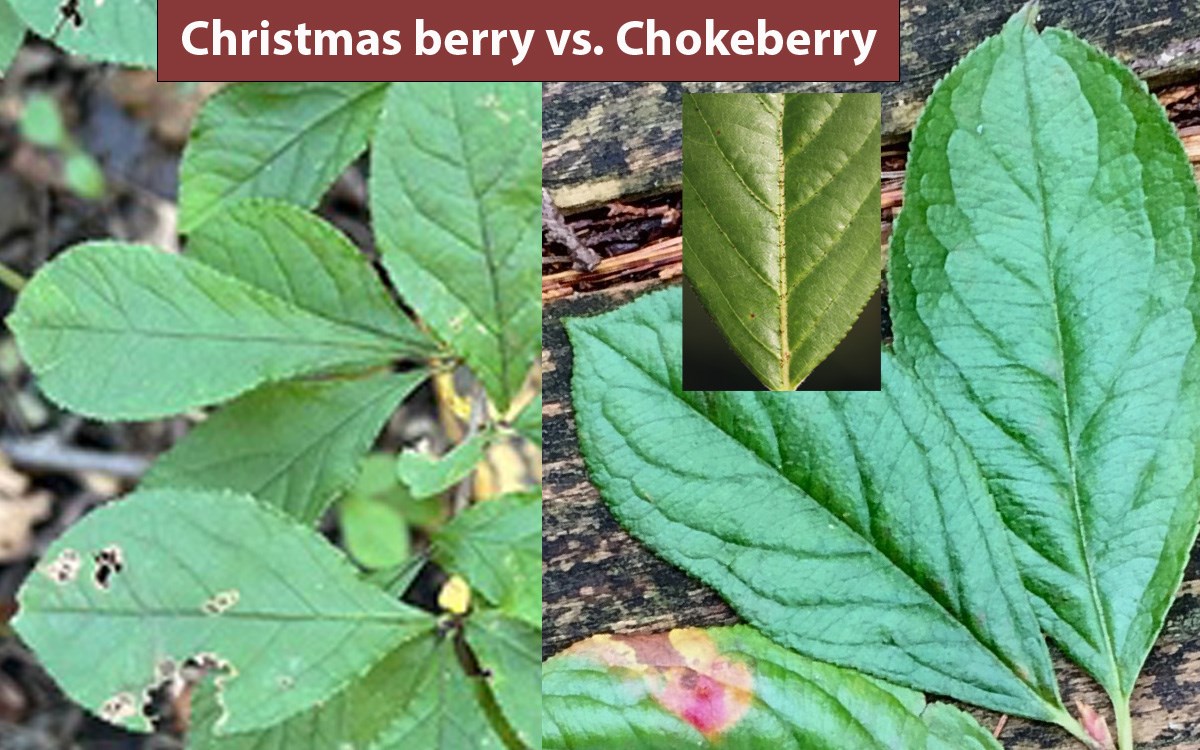
Christmas berry Credit: Kellycarrot (CC BY-NC). Chokeberry Credit: Ken Kniedel (CC0). Chokeberry leaf inset Credit: Dwayne Estes (CC BY-NC).
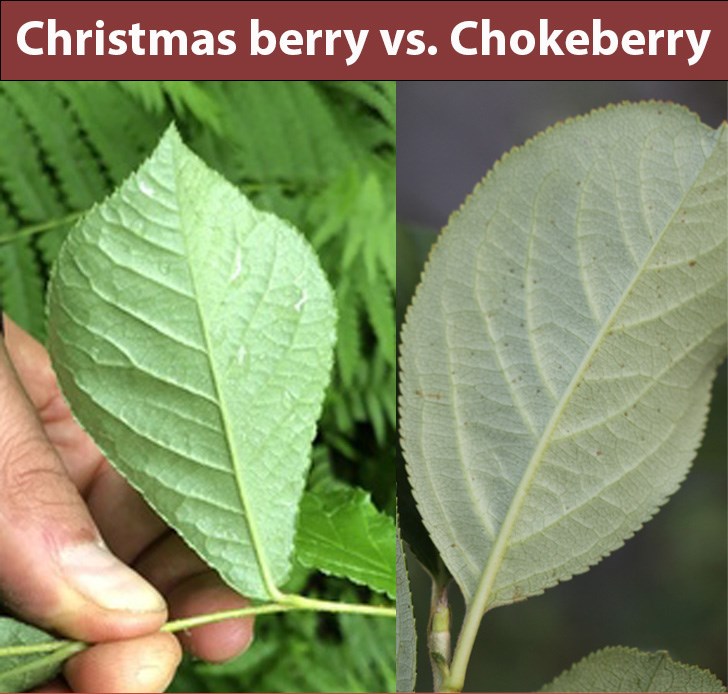
Christmas berry Credit: Josh Rudder (CC BY-NC). Chokeberry Credit: Dwayne Estes (CC BY-NC)
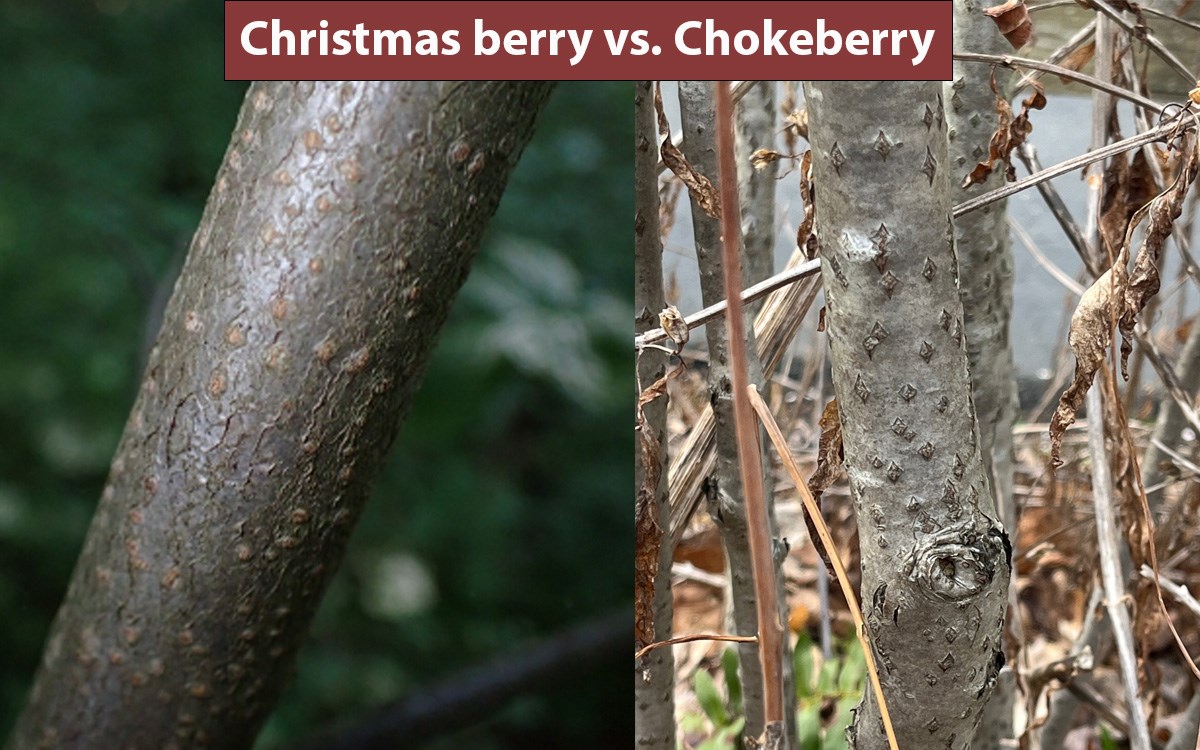
Christmas berry Credit: Sus_scrofa (CC BY). Chokeberry Credit: Yvonne Ng (CC BY-NC)
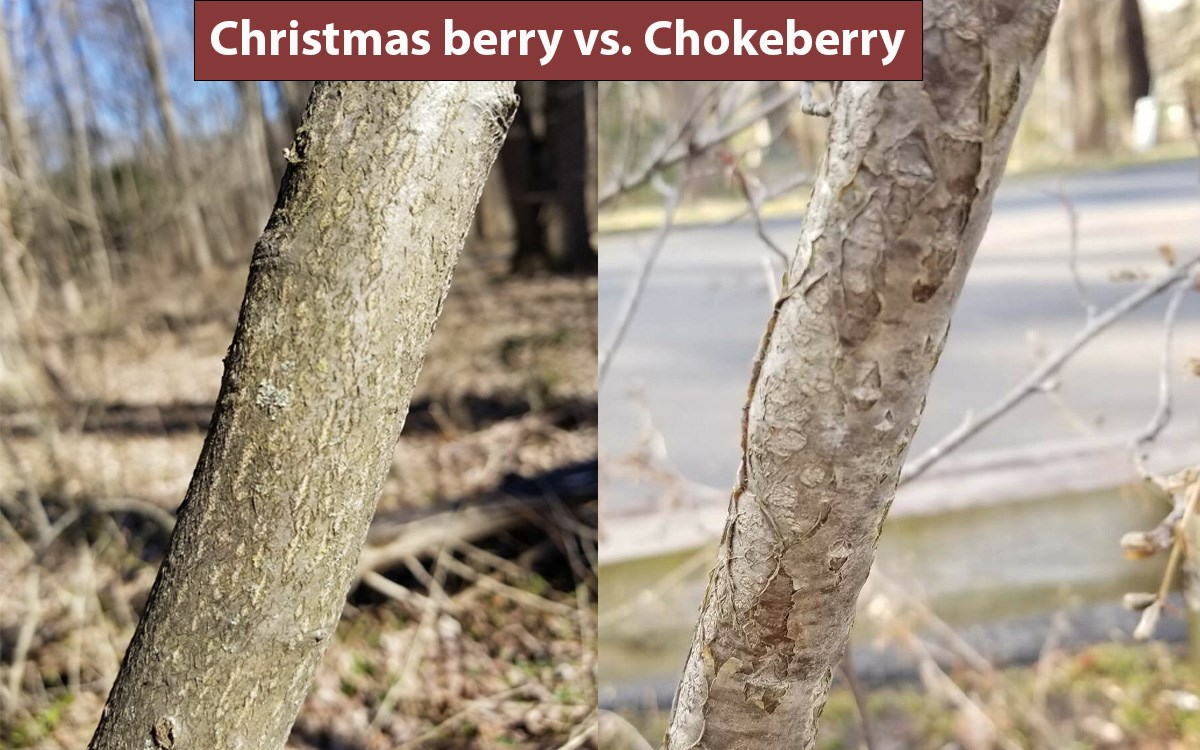
Christmas berry Credit: Bradely Simpson (all rights reserved). Chokeberry Credit: Bradley Simpson (all rights reserved).
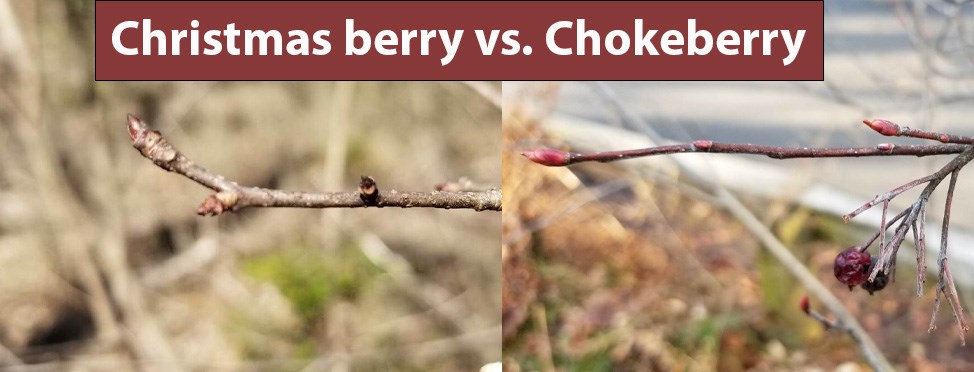
Christmas berry Credit: Bradley Simpson (all rights reserved). Chokeberry Credit: Bradley Simpson (all rights reserved).
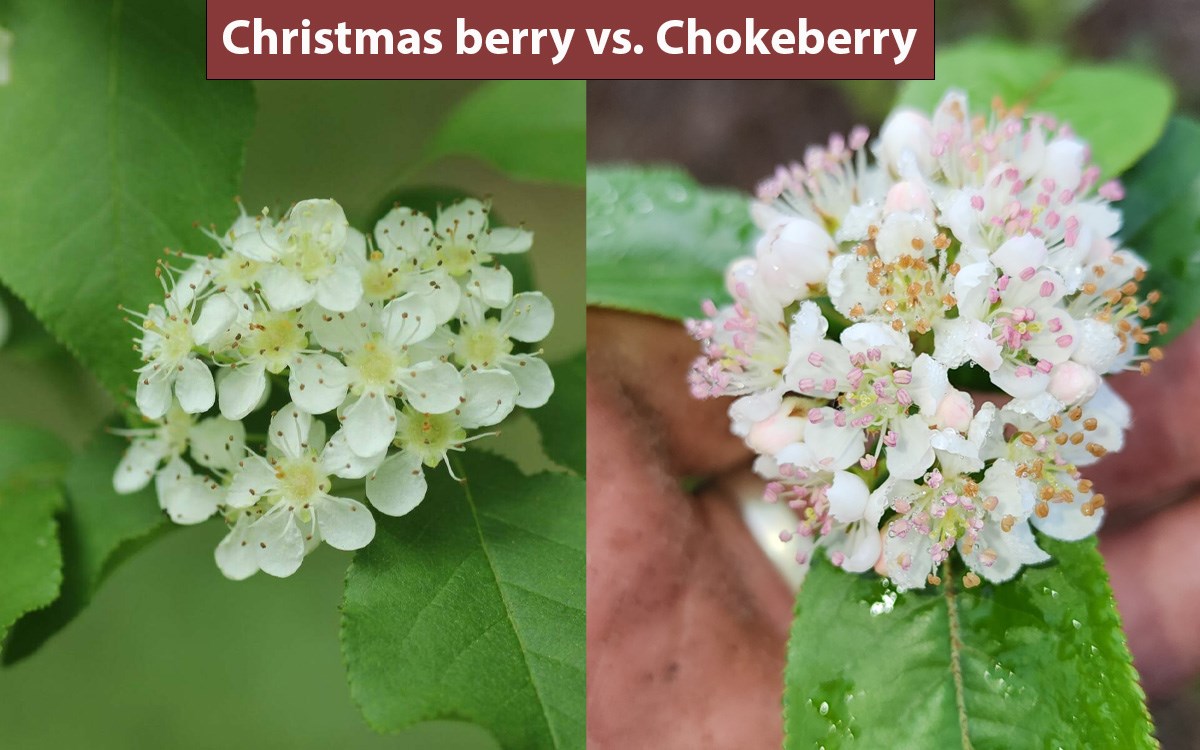
Christmas berry Credit: tosakah (CC BY-NC). Chokeberry Credit: Scott Allen Davis (CC BY).
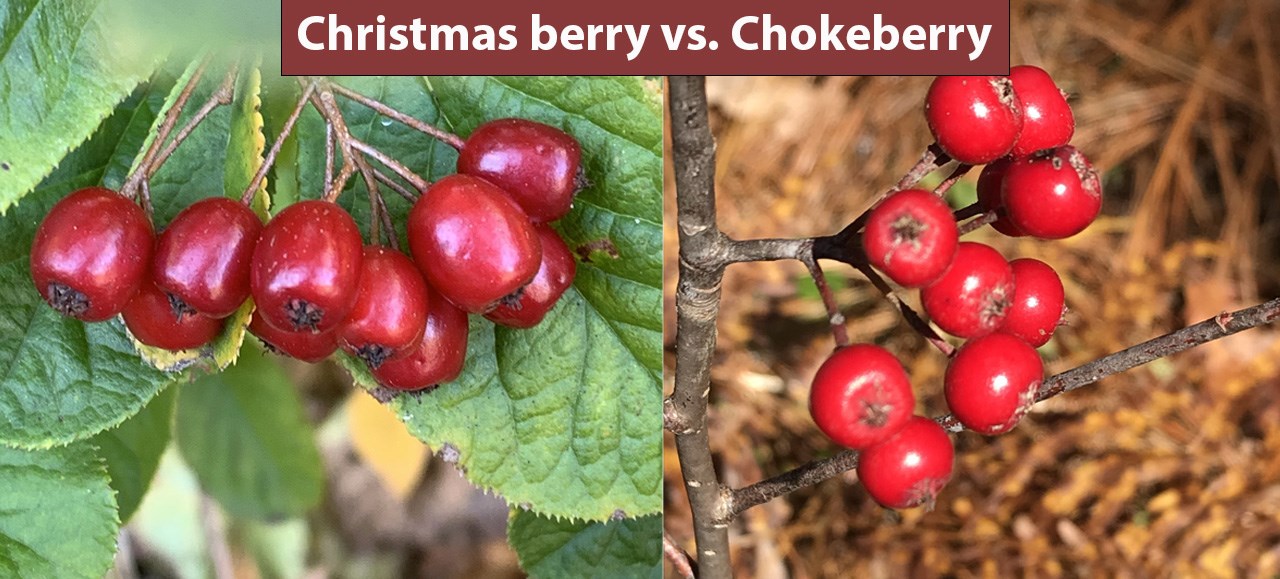
Christmas berry Credit: Uri Sang (CC BY-NC). Chokeberry Credit: Laura Clark (CC BY).
Tips for making a good observation on iNaturalist
Note: The scientific name for Christmas berry on iNaturalist is Pourthiaea villosa.
Take photographs that show:
- The landscape around the plant – this shows the habitat
- If they are flowering, photograph a whole plant including flowers and leaves
- If not flowering yet, photograph both surfaces of a whole, typical, undamaged leaf. With Christmas berry, you should be able to see fruits during late summer
Make comments that:
- Are explicit about the issue of cultivated plant vs weed
- Provide the location or landmark, or which direction from a trail or path
- Give a rough estimate of the number of plants and the area covered any other comments you think might be helpful
References
Brookman, S., & Rawlins, K. A. (2015, March 18). Photinia villosa/NJ. BugwoodWiki. https://wiki.bugwood.org/Photinia_villosa/NJ
North Carolina State University. (n.d.). Aronia arbutifolia. North Carolina Extension Gardener Plant Toolbox. https://plants.ces.ncsu.edu/plants/aronia-arbutifolia/
Photinia villosa. Lower Hudson Partnership for Regional Invasive Species Management. (n.d.). https://www.lhprism.org/species/photinia-villosa
Photinia villosa (Thunberg) Candolle. Flora of China. (n.d.). http://efloras.org/florataxon.aspx?flora_id=2&taxon_id=200011018
Tags
- anacostia park
- antietam national battlefield
- baltimore-washington parkway
- catoctin mountain park
- chesapeake & ohio canal national historical park
- fort washington park
- george washington memorial parkway
- harpers ferry national historical park
- manassas national battlefield park
- monocacy national battlefield
- national capital parks-east
- piscataway park
- prince william forest park
- rock creek park
- wolf trap national park for the performing arts
- invasive species
- invasive plants
- non-native invasive
- ipmt
- prism
- invasive species spotlight
- natural resource quarterly
- summer 2024
- shrub
- edrr
- early detection
- ncr
- nature
- maryland
- virginia
- dc
- wv
- chokeberry
- christmas berry
